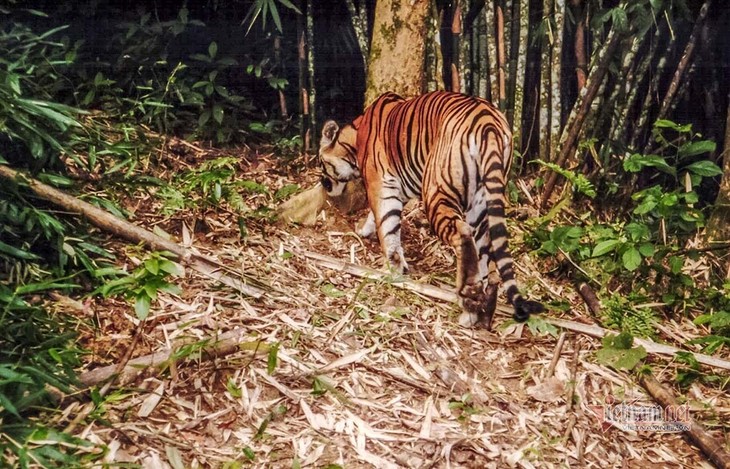B: We’d like to welcome back Tim Brockett of the US. He wrote: “I enjoy listening to your station. It has been many years since I Dx’ed. In the 1970's I frequently tuned into MW and SW stations around the world. I learned a great deal about other countries and enjoyed listening. Unfortunately a fire destroyed my radio equipment and my QSL card collection. Now that I am retired, I picked up my previous hobby and started to once again listen and learn. I still find it somewhat magical, in a way the Internet was never able to convey, that I can listen to distant voices and music gathered from thin air.”
A: We’re very happy to welcome you back after a long time. Tim said he listened to VOV on March 13 on 7220khz in Enschede, Netherland. He used an Airspy HF+ Discovery radio connected to a loop antenna. He has it connected to a laptop running SDR software.
B: He said: “I understand that reception reports have been replaced with accurate wave coverage charts. Thus my report may be useless except to let you know that your audience is spread far and wide. Perhaps that will be helpful information for the advertising department.”
A: Listeners’ technical feedback and comments are always useful for us to manage the broadcast and improve our program. Over the last 2 years we have suspended sending paper QSL cards to listeners and issued eQSL cards instead. We’ll email you a verification card for your QSL card collection.
B: Maguy Roy, a French listener, said he is interested in the photo reportage of the Hue Tiger Arena, a special colosseum in Vietnam. Indochinese tigers, which are native to Myanmar, Vietnam, Thailand, and Laos, are threatened with extinction. Roy wants to know about elephants and tigers in Vietnam in the wild and in captivity and if Vietnam has policies to protect them.
 The last image of a tiger captured by an automatic carema in Pu Mat National Park in Nghe An in 1999. The last image of a tiger captured by an automatic carema in Pu Mat National Park in Nghe An in 1999. |
A: According to the World Wildlife Fund there were fewer than five tigers left in the wild in Vietnam in 2016. The International Union for Conservation of Nature and Natural Resources said there are no signs of the presence of wild tigers in Vietnam and there has been no further survey of tigers in Vietnam since 2009. Although there has been no official statement, many people believe tigers may have become extinct in Vietnam.
B: From 2018 to 2020, rangers in Pu Mat National Park in Nghe An province set up more than 600 photo traps using 200 automatic cameras. The locals have reported seeing tiger tracks in Pu Mat National Park near the Vietnam-Laos border, but rangers have been unable to obtain any photos of tigers.
|
7 tiger cubs rescued from traffickers in 2021 are being raised at Pu Mat National Park. (photo: tuoitre.vn)
|
A: In January Education for Nature Vietnam organised a seminar on tigers in the wild and raising tigers for conservation in Vietnam. It said the wild tiger population has decreased significantly in Vietnam and all around the world over the past 30 years. Meanwhile, the breeding of tigers for non-commercial purposes by individuals and businesses in Vietnam is growing, with the number of registered captive tigers increasing over the years.
B: State agencies have conducted surveys and made records of tigers being raised in Vietnam, and have created a national database to manage tigers in captivity within the framework of the National Program on Tiger Conservation.
A: Vietnam still has wild elephants, but unfortunately their number is so small these days that the chance of seeing them in the wild is near 0%. The type of elephant in Vietnam is the Asian elephant, which is the largest mammal in Asia.
 Elephant race in Don village, Dak Lak province (photo: baodantoc.vn) Elephant race in Don village, Dak Lak province (photo: baodantoc.vn) |
B: The Center for People and Nature Conciliation reports that in the 1990s Vietnam had 1,500-2,000 elephants in the wild but that number has dropped dramatically to 124-148.
A: There were 165 domesticated elephants in 2000 but just 91 in 2018. These animals live in zoos, parks or tourism areas in 11 cities and provinces.
B: The best chance to see elephants is in Yok Don National Park in the Central Highlands province of Dak Lak. The central highlands, especially Dak Lak province, used to be the main habitat of elephants in Vietnam. Elephants were once used to work in the timber industry and carry tourists. Riding elephants has been discontinued to avoid accidents and help preserve the animals. Some of these elephants are free to walk about in the national park with their personal mahout. The mahouts keep an eye on the elephants and make sure they do not leave the park.
A: Another national park where elephants live is Pu Mat National Park in Nghe An province, which borders Laos, but there is an extremely small chance of spotting a wild elephant here.
 Elephants in Pu Mat National Park (photo: baonghean.vn) Elephants in Pu Mat National Park (photo: baonghean.vn) |
B: The Elephant Habitat and Species Conservation Area in Quang Nam was established in 2017. The US Agency for International Development has supported it in conducting biodiversity inventories, developing a Sustainable Forest Management Plan, raising conservation awareness among local communities, and providing job opportunities for people living in and around the protected area.
A: Ever since the sanctuary was established, the elephants there have been free from human interference, their habitat guaranteed, their food source more stable. Over the past several years, they have stopped intruding into local fields in their search for food.
B: This week we continued to receive reception reports from our regular listeners, who write to us on a weekly basis.
A: Shivendu Paul, a member of the Metali Listeners’ Club and the VOV Fan Club of of India, said he listened to VOV’s English program the whole week from March 7 to 13 and got moderate reception 1600 and 1630 UTC on 7220 and 9730 khz on a Grundig YB 80 receiver from West Bengal.
B: Ratan Kumar Paul of India tuned in to VOV on March 8 on 7220khz using a Grundig Digital receiver with a telescope antenna. He rated SINPO all 3s.
A: Muhammad Aqeel Bashir, Head of the Pak Listeners Club and member of the International Radio Listeners Organization Pakistan reported that the program on March 14 on 9840khz was good, with SIO at all 4s.
B: David Ansell of England sent us a letter saying that he listened to a program beamed to Europe on February 26 on 11885khz. The reception was fair, good signal, no interference, local noise, and moderate fading.
A: Thank you all for listening to VOV and writing to us. We welcome your comments and suggestions at English Service, VOVworld, the Voice of Vietnam, 45 Ba Trieu street, Hanoi, Vietnam.
B: Our email address is: englishsection@vov.vn. You’re invited to visit us online and leave your comments at vovworld.vn. Once again, thank you all for listening. Goodbye.